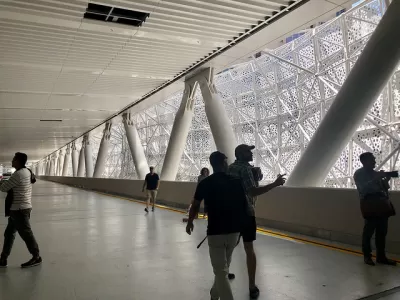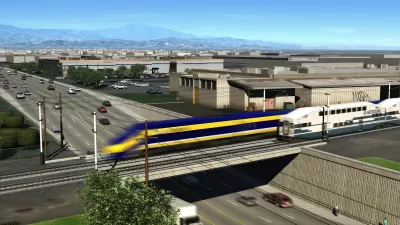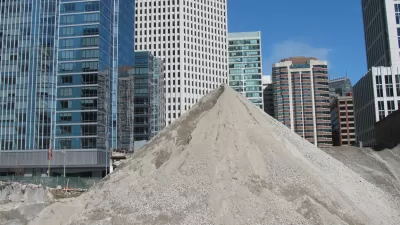To great fanfare, the Salesforce Transit Center opened on Saturday to thousands of visitors anxious to see the huge facility. Sunday was quieter, with the first AC Transit buses arriving on the third-floor bus deck. Train arrivals: TBD.

"Thousands of visitors jammed the new Transbay Transit Center for its grand opening party Saturday," reports Lauren Hernández for The Chronicle. "Lines stretched the length of the Grand Hall as people tried to get into the $2.2 billion multistory transportation hub." [Article includes an 11-slide photo gallery by Paul Chinn of the 3-block transit center with 5.4-acre rooftop park].
Shortly before 6 a.m. on Sunday, the first bus from Oakland entered the third-floor bus deck from a direct ramp from the Bay Bridge," reports The Chronicle's urban design critic, John King. A sponsorship agreement with Salesforce "is why the publicly funded structure’s official name is Salesforce Transit Center," adds King.
Rachel Swan, who covers transportation for The Chronicle, reported on Thursday on the train dimension for the new transit center.
There is no firm timeline or funding source for the long-promised train service. While transportation officials seek to build momentum for this next phase, San Francisco City Hall is touting a new approach that could raise the cost to $6 billion from an already expensive $4 billion.
Hernández wrote that "high-speed rail service between the Central Valley and San Francisco is scheduled to arrive in 2029," but all bets are off due to the uncertainty associated with a lack of funding and a new governor taking office next January.
Caltrain, the commuter line from San Jose and points south, would be expected to arrive at that time assuming a tunnel is built and tracks laid. Electrification construction along the Peninsula is well underway, a necessity for the train to use the new terminal. Accessing the center from the train's current terminal at Fourth and King Street, a distance of one and one-half miles, is the hurdle.
The challenge of picking a route for the trains that would work for decades to come defies easy solutions. And it’s eluded City Hall and the Transbay Joint Powers Authority — the independent government agency in charge of the transit center and rail extension — for years.
Swan describes the current planning, centering on the proposed Pennsylvania Avenue extension which "quickly caught on at City Hall, finding favor with supervisors and other officials who have to agree on the route before the Joint Powers Authority can pursue it."
But the revision leaves out how to finance the project. So far the city has identified only $1 billion in funding from a mix of sources, including sales taxes and bridge toll money from Regional Measure 3 approved by voters in June. Much of the rest would come from federal and state funds that would need approval.
Mark Zabaneh, the authority’s executive director, "aims to have the rail line ready for construction by 2020, meaning all environmental reviews would need to be complete, and the right-of-way acquired to lay the original 1.3 miles of track from Seventh and Townsend streets to Second and Howard streets," adds Swan.
The money will follow, Zabaneh said, and if everything goes smoothly, the rail extension will be complete by 2029.
Still, skeptics and even some supporters worry about the escalating costs. Some note that the increase comes at an uncertain time for federal and state funding: The GOP-led federal government may be reluctant to shower funds on progressive San Francisco, Sen. Scott Wiener (D-San Francisco) said, and state officials are fighting to protect the newly enacted gas tax — a key source of revenue for the proposed rail line and other transit projects — from a ballot measure to repeal it this November.
“If we don’t get Caltrain, and eventually high-speed rail, into Transbay Terminal it will go down as the most expensive bus terminal in the history of humankind,” said San Francisco Supervisor Aaron Peskin, who also who chairs the board’s Transportation Authority
From Planetizen's archives:
- Blog post: S.F.'s Transbay Transit Center: Grand Central Station of the West, or Billion Dollar Bus Station?
March 6, 2017
The developers of San Francisco’s Transbay Transit Center say it has the potential to change travel patterns in the region and land use in the neighborhood, as did New York City’s Grand Central Terminal. How realistic is this promise?
- Is This America's Next Great Train Station?
March 31, 2013
Remember this past week when we asked where America's next generation of grand transit hubs would be built? It turns out one may be destined for San Francisco.
FULL STORY: Salesforce Transit Center puzzle: When will the trains get to the station?

Alabama: Trump Terminates Settlements for Black Communities Harmed By Raw Sewage
Trump deemed the landmark civil rights agreement “illegal DEI and environmental justice policy.”

Planetizen Federal Action Tracker
A weekly monitor of how Trump’s orders and actions are impacting planners and planning in America.

The 120 Year Old Tiny Home Villages That Sheltered San Francisco’s Earthquake Refugees
More than a century ago, San Francisco mobilized to house thousands of residents displaced by the 1906 earthquake. Could their strategy offer a model for the present?

Opinion: California’s SB 79 Would Improve Housing Affordability and Transit Access
A proposed bill would legalize transit-oriented development statewide.

Record Temperatures Prompt Push for Environmental Justice Bills
Nevada legislators are proposing laws that would mandate heat mitigation measures to protect residents from the impacts of extreme heat.

Downtown Pittsburgh Set to Gain 1,300 New Housing Units
Pittsburgh’s office buildings, many of which date back to the early 20th century, are prime candidates for conversion to housing.
Urban Design for Planners 1: Software Tools
This six-course series explores essential urban design concepts using open source software and equips planners with the tools they need to participate fully in the urban design process.
Planning for Universal Design
Learn the tools for implementing Universal Design in planning regulations.
Clanton & Associates, Inc.
Jessamine County Fiscal Court
Institute for Housing and Urban Development Studies (IHS)
City of Grandview
Harvard GSD Executive Education
Toledo-Lucas County Plan Commissions
Salt Lake City
NYU Wagner Graduate School of Public Service





























